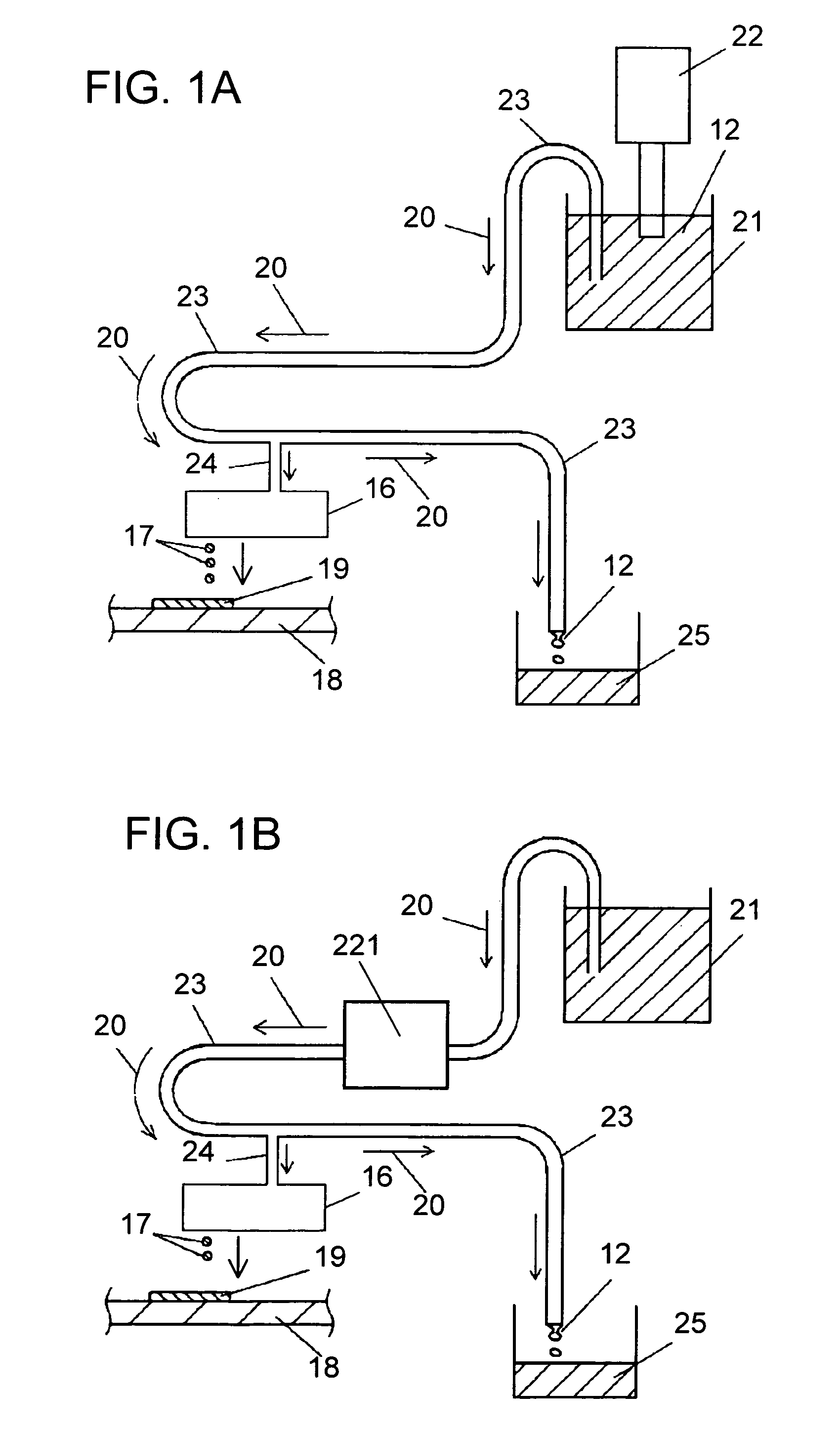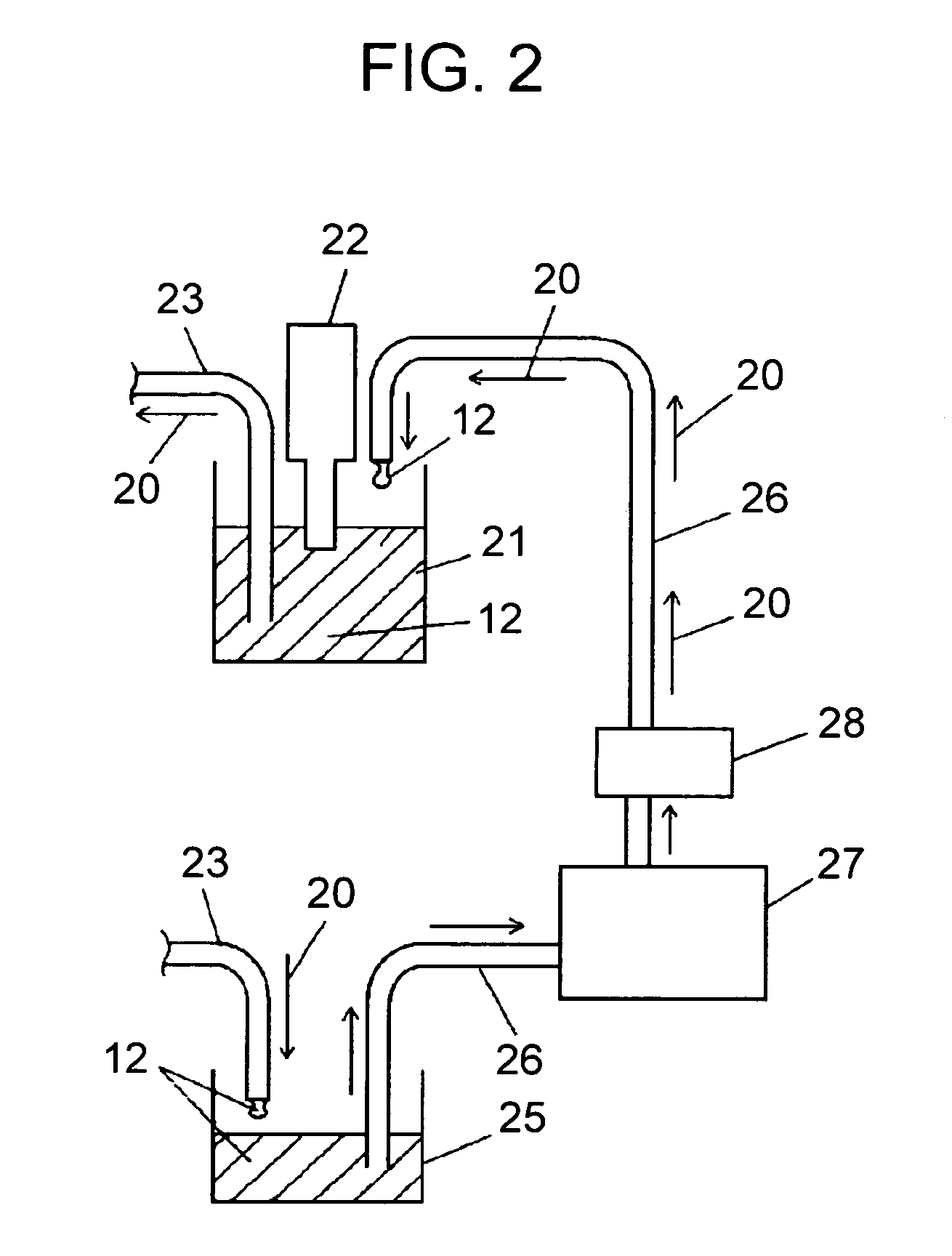Ink jet device, ink jet ink, and method of manufacturing electronic component using the device and the ink
a technology ink, which is applied in the direction of printing, conductive pattern formation, capacitors, etc., can solve the problems of poor stability of ink jet printing, inability to use dielectric materials, magnetic materials, etc., and achieve poor stability and printing with ink jet
- Summary
- Abstract
- Description
- Claims
- Application Information
AI Technical Summary
Benefits of technology
Problems solved by technology
Method used
Image
Examples
first embodiment
[0043]An ink jet apparatus and its ink-supplying system of a first embodiment of the present invention will be described, with reference to FIG. 1A. An interior of ink tank 21 of FIG. 1A is filled with ink 12. Dispersing unit 22 disperses ink 12 in ink tank 21 as required. The ink stored in tank 21 flows by its own weight via first tube 23 into ink collecting tank 25. Setting ink tank 21 to a position higher than that of ink-collecting tank 25 can provide the ink with natural flow, on a principle of a siphon, without using a pump or the like. Through the process above, ink 12 in tank 21 flows through first tube 23 and drips down into tank 25. According to the present invention, ink 12 has constant flow through first tube 23 and some of the ink to be used for printing is carried through second tube 24 to printer head 16. Printer head 16 filled with ink 12 jets out the ink on a “drops-on-demand” basis in response to an external signal (not shown) to form droplets 17. Droplets 17 land ...
second embodiment
[0057]An example in which removing fine bubbles mixed into the ink further improves printing stability is explained. In a case that the ink jet apparatus having piezoelectric printer head 16 is employed, it is known that bubbles entered into the ink reside and grow in the printer to absorb vibration energy of piezoelectric elements and cause unstable printing (see P. 202–206 of “Ink jet printing technology and materials” compiled under the supervision of Takeshi Amari, professor at Chiba Univ., published from CMC Publishing Co. 1998). In particular, the present invention has a structure in which dispersing unit 22 is fixed to ink tank 21. A problem is that employing a high-speed rotating homogenizer or ultrasonic dispersing unit for dispersing unit 22 can entrain fine bubbles into ink tank 21. For example, in the case of using the high-speed rotating homogenizer, bubbles captured from a surface of the ink are often observed; similarly, in the case of the ultrasonic dispersing unit, ...
third embodiment
[0066]In a third embodiment, a more detailed explanation of a distinctive feature of the present invention—circulation and dispersion of ink—will be given hereinafter. FIGS. 6A and 6B show data obtained by measurement of precipitation velocity of practically used ink for manufacturing electronic components. In particular, the ink for manufacturing electronic components has an extremely easy-to-aggregate property, thereby it tends to form precipitates. Here will be given a more detailed explanation of the aforementioned property, referring to FIGS. 6A and 6B. In FIG. 6A, ink tank 21 is filled with ink 12. Dispersing unit 22 is put into ink 12, with a switch being OFF(switch off). When dispersing unit 22 is kept in OFF mode, i.e., the ink is left with no movement, as shown in FIG. 6A, clear layer 36 appears in ink 12 with passage of time. Clear layer 36 grows thicker as time goes by. FIG. 6B illustrates a process of developing each clear layer in three types of ink for manufacturing e...
PUM
| Property | Measurement | Unit |
|---|---|---|
| inner diameter | aaaaa | aaaaa |
| inner diameter | aaaaa | aaaaa |
| viscosity | aaaaa | aaaaa |
Abstract
Description
Claims
Application Information
 Login to View More
Login to View More - R&D
- Intellectual Property
- Life Sciences
- Materials
- Tech Scout
- Unparalleled Data Quality
- Higher Quality Content
- 60% Fewer Hallucinations
Browse by: Latest US Patents, China's latest patents, Technical Efficacy Thesaurus, Application Domain, Technology Topic, Popular Technical Reports.
© 2025 PatSnap. All rights reserved.Legal|Privacy policy|Modern Slavery Act Transparency Statement|Sitemap|About US| Contact US: help@patsnap.com



